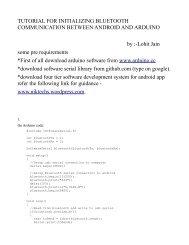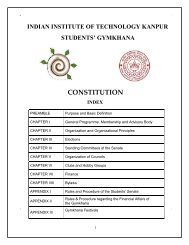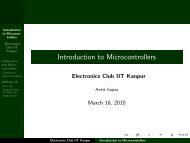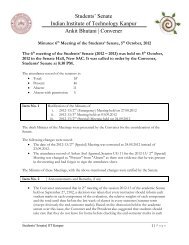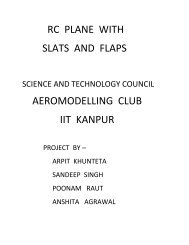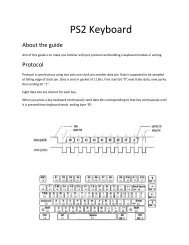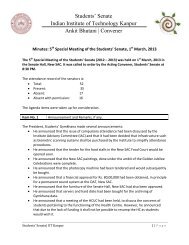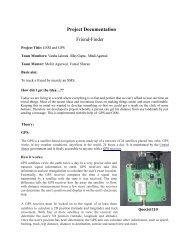new ENERGY AUDIT OF IIT KANPUR HOSTEL AREA-1
new ENERGY AUDIT OF IIT KANPUR HOSTEL AREA-1
new ENERGY AUDIT OF IIT KANPUR HOSTEL AREA-1
Create successful ePaper yourself
Turn your PDF publications into a flip-book with our unique Google optimized e-Paper software.
Project Samadhan<br />
An average flat plate collector area of 2 m^2 gives 125L of hot water per day. [1]<br />
Thus total collector area required = 9240/125x2 = 147.84 m^2<br />
Assuming cost of installation to be around 10,000 Rs/m^2 total capital cost<br />
comes out to be = 14,78,400Rs<br />
Total geyser usage in the hostel for approximately 12 hrs on a typical cool day<br />
for 2.3 kW geysers installed in the hostel = 12x2.3x21= 579.6 kWh<br />
Geysers are typically operational in <strong>IIT</strong> Kanpur for about 120 days from<br />
November to February. Thus total energy consumption = 120x579.6 = 69552<br />
kWh<br />
Total expense with geysers = 69552x3.5 Rs/kWh = 243432 Rs.<br />
Thus simple payback period = 14,78,400 / 243432 = 5.25 years.<br />
Clearly this is a comfortable payback period and it is advisable to have solar<br />
water heaters installed in this facility.<br />
The same calculation is done for all the hostels of <strong>IIT</strong>K<br />
Residents<br />
hot<br />
water<br />
required<br />
collector<br />
area<br />
m^2<br />
Capital<br />
investment<br />
INR<br />
annual<br />
saving<br />
(INR)<br />
no of<br />
payback<br />
geysers<br />
(years)<br />
Hall-1 452 9040 144.64 1446400 21 243432 5.9417<br />
Hall-2 459 9180 146.88 1468800 21 243432 6.033718<br />
Hall-4 486 9720 155.52 1555200 24 278208 5.590062<br />
Hall-5 450 9000 144 1440000 24 278208 5.175983<br />
Hall-6 112 2240 35.84 358400 6 69552 5.152979<br />
Hall-7 410 8200 131.2 1312000 30 347760 3.772717<br />
Hall-8 489 9780 156.48 1564800 24 278208 5.624569<br />
Hall-9 300 6000 96 960000 27 312984 3.067249<br />
GH-1 310 6200 99.2 992000 21 243432 4.07506<br />
The payback period of all the facilities is around 5-6 years which is certainly<br />
affordable considering the environmental impact of this technology.<br />
Furthermore data clearly suggest that even while having almost the same<br />
architecture and number of students the per capita electricity consumption of<br />
Hall 2 and 3 is different and the difference clearly has a correlation with the solar<br />
heater that have been installed in Hall 3. This is further confirmed by the fact<br />
that in winter Hall 3 and Hall 2 per capita electricity consumption differences<br />
grows even further.<br />
2. Replacement of rheostatic regulators with electronic<br />
However studies done at <strong>IIT</strong> Bombay have shown that the electronic regulator is<br />
more energy efficient but experience suggests that resistive regulators are more<br />
durable. Though it is still mentioned here as a possible option.<br />
The Group for Environment and Energy Engineering 18



